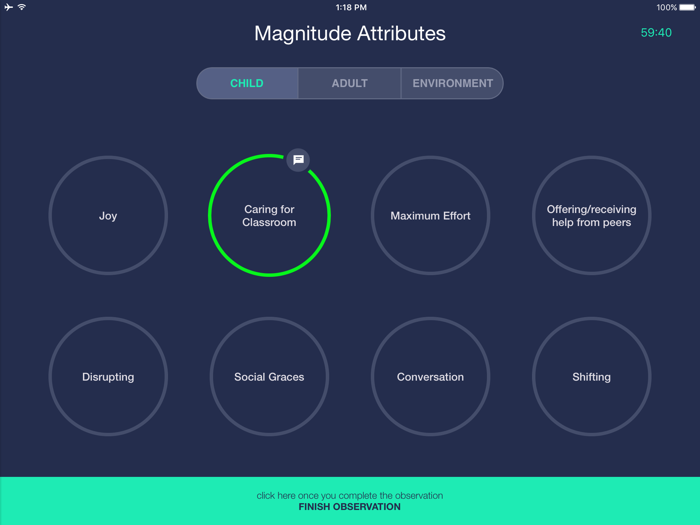About the DERS
RESEARCH is telling us what OUTCOMES really MATTER for children:
executive functions · linguistic and cultural fluency · social-emotional development
And how to SUPPORT those OUTCOMES in classrooms:
Order in the environment · Engagement with purpose · Friendliness with error · Joy
“I appreciate that you can use the qualitative data collected to measure if a class is performing well.”
The DERS is a classroom observation and coaching tool that measures
environmental and behavioral qualities proven to support those outcomes—
for any developmental educational model.
Assessment
How it Works: A trained observer rates 60 attributes — 20 each for the child, the adult, and the environment — over a one-hour observation. Observers can tap to rate, switch back and forth between areas, and revise ratings or add notes.
Reporting
Reporting: At the end of the observation, the DERS creates a report showing scores across five domains of measurement, an editable narrative summary, and prompts for coaching conversations around DERS items.
Reports can be saved, printed, and emailed, and results can be tracked over time.
The Science
Five Domains
The DERS focuses on five outcomes:
initiation and concentration
inhibitory control
working memory
linguistic and cultural fluency
social-emotional flexibility
The first three domains are aspects of executive function. The last two are important developmental skills which are themselves influenced by executive function.
Executive Function
Research has shown that executive functions (the neurocognitive functions which enable us to pay attention, control behavior, and think flexibly), as well as deep literacy and social-emotional learning, are key developments which can be nurtured in classrooms, and are highly predictive of academic and life success. A full bibliography is included in the DERS Technical Manual, available to users.
Multiple domains:
Many of the DERS attributes map to more than one domain. For example, uninterrupted learning time, free choice, voluntary physical movement, and calm, predictable, and respectful adult behavior support outcomes across all areas.
Validity
The DERS has content validity and strong inter-rater reliability.
The Validation Process
Content validity:
The 60 observable attributes are each tied to one or more outcome domains by published research. A full bibliography is included in the DERS Technical Manual.
Inter-rater reliability:
The training and certification process includes a norming procedure and a reliability test to ensure Inter-rater reliability





